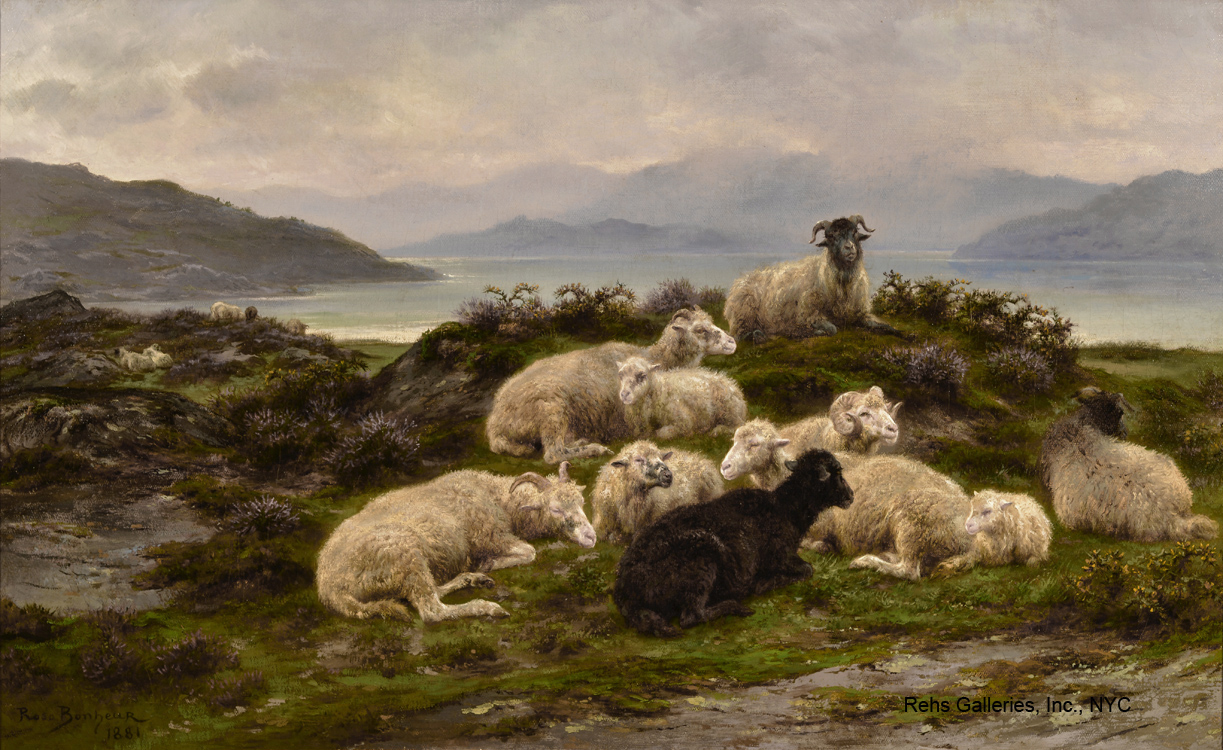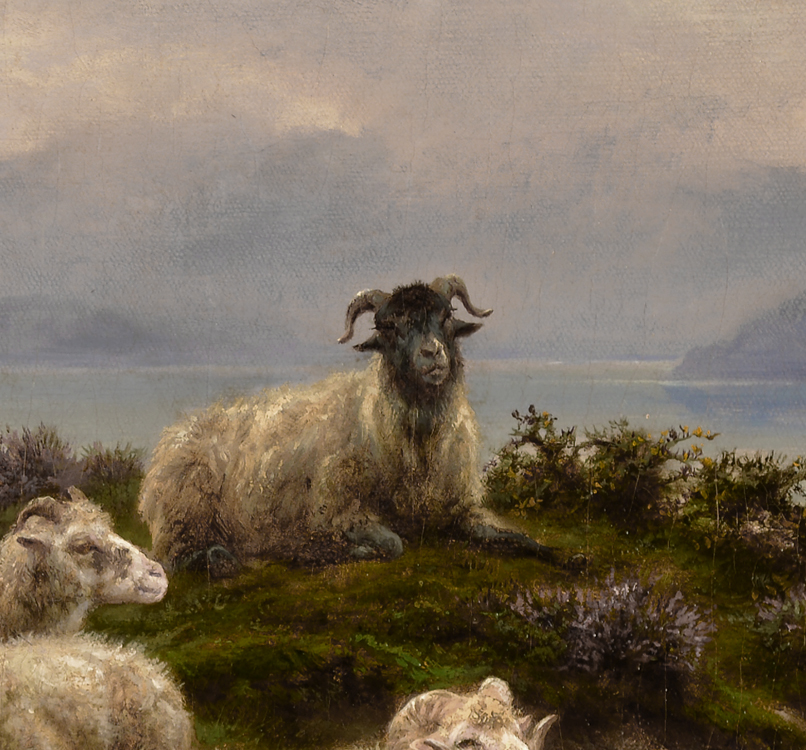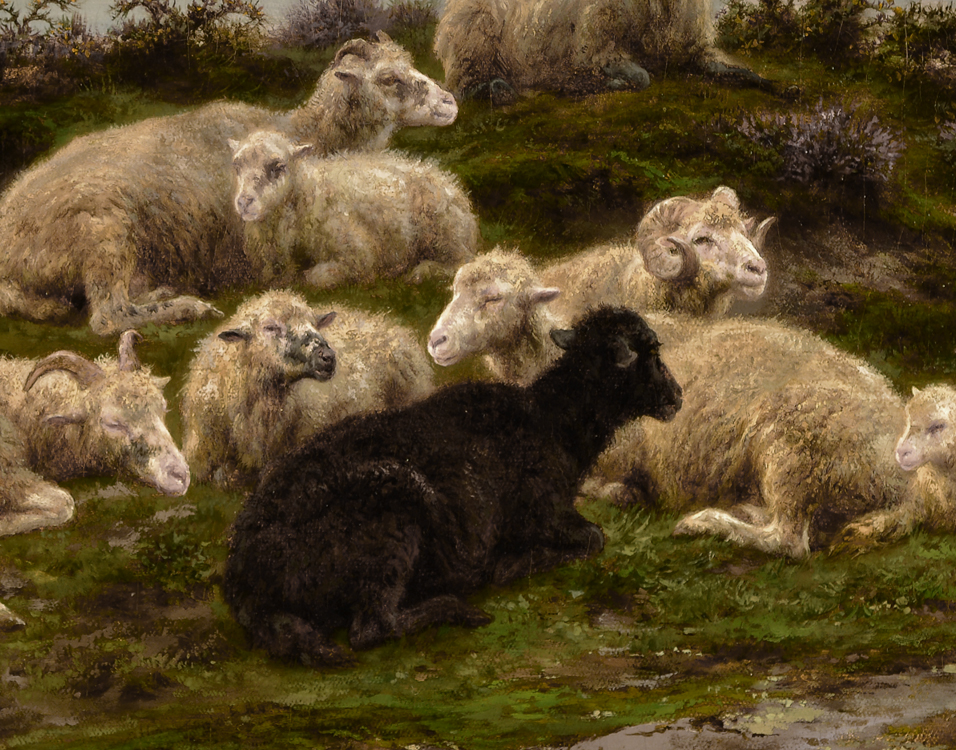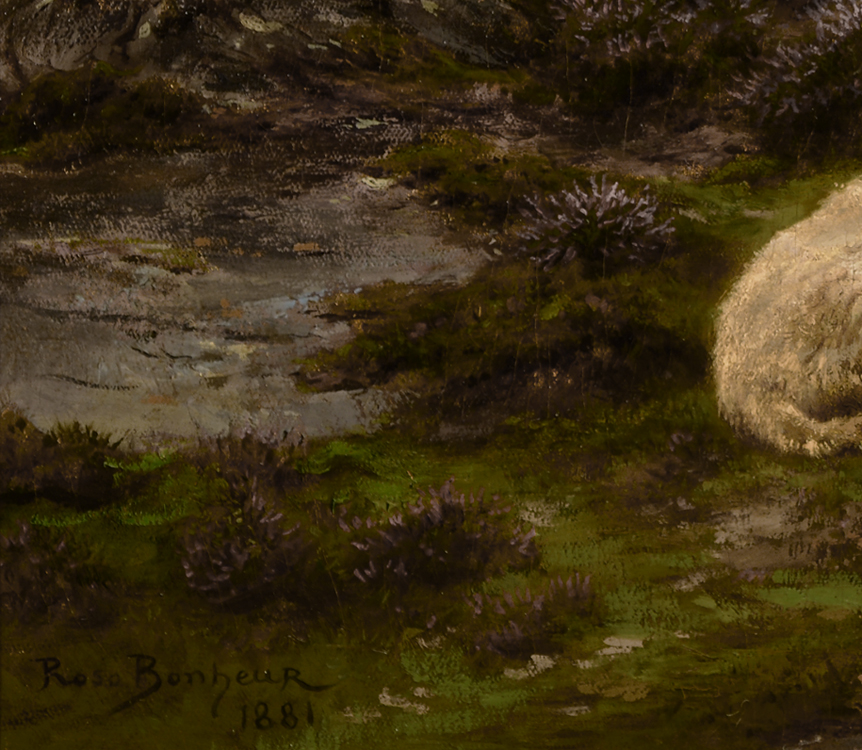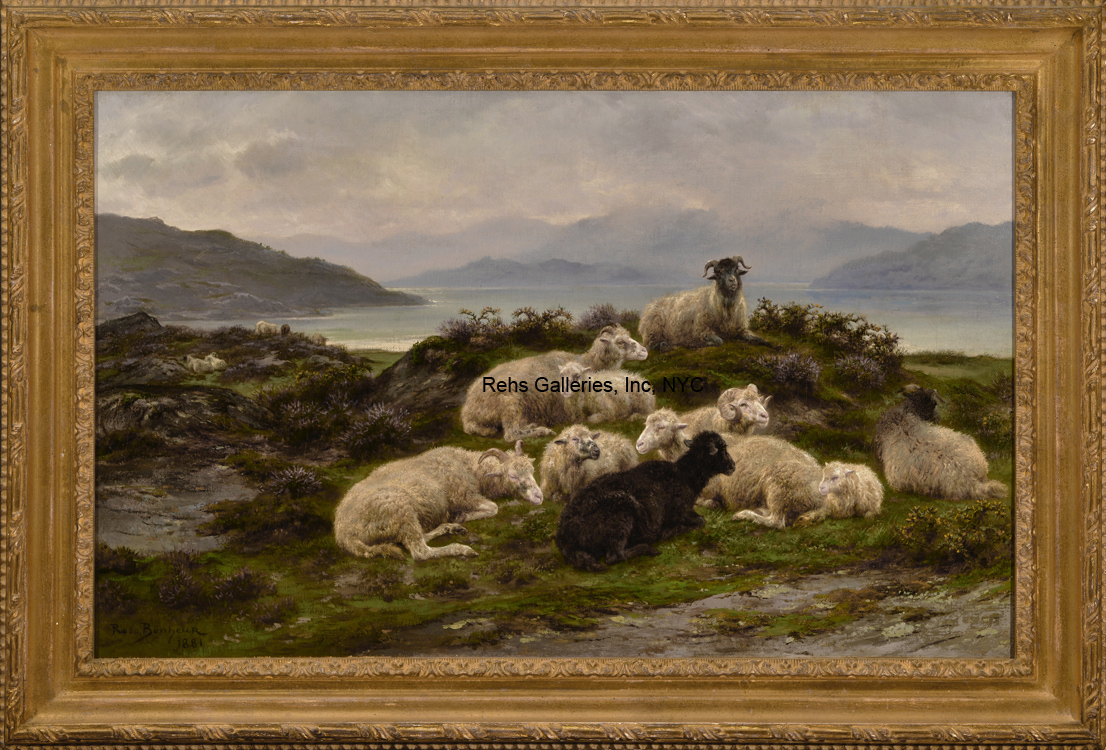Rosa Bonheur
(1822 - 1899)
Sheep Resting in a Landscape
Oil on canvas
18 x 29 inches
Framed dimensions:
23 x 34 inches
Sigend and dated 1881
BIOGRAPHY - Rosa Bonheur (1822 - 1899)
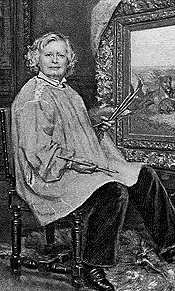
Rarely during the nineteenth century did the artistic career and recognition of a woman eclipse that of her male counterparts. History recognizes few females from this period in the position of artistic authority, but Rosa Bonheur established herself as the foremost “animalier,” or animal painter, linked with landscape painting and the Realist tradition. Through contacts, exhibitions, and reproductions disseminated worldwide, Rosa Bonheur’s work was well known throughout Europe and America. Her unusual ways attracted considerable public attention and she harnessed this interest throughout her life and established a niche, commercially and artistically, for her work, becoming one of the most original figures of the 19th century.
Marie-Rosalie Bonheur was born March 16th, 1822 in Bordeaux, France. She was one of four children, each trained as an artist. Most influential in her life, both artistically and socially, was her father, Oscar-Raymond Bonheur, also a trained artist and devout socialist. During Rosa’s childhood, Raymond was involved with the Saint-Simonians, a political group established in the small town of Menilmontant. The Saint-Simonians advocated a form of socialism which expressed a desire for the equality of women and men and abolishment of class distinctions, among other goals. While radical in its political and social nature, the Bonheur family supported Raymond in this idealist pursuit of social unity and amelioration. Raymond’s association with this group contributed to Rosa’s liberal outlook and defiant personality leading to her dressing as a male, cutting her hair short, and smoking cigarettes and cigars much to the disdain of and the misunderstanding of many. Her actions and personality have placed her in a decisive position in early feminism. She wrote that “To [my father’s] doctrines I owe my great and glorious ambition for the sex to which I proudly belong and whose independence I shall defend until my dying day.” (Britta C. Dwyer, "Rosa Bonheur and Her Companion-Artist: What Made Anna Klumpke Special?", in Rosa Bonheur: All Nature's Children, ex. cat. New York: Dahesh Museum, 1998, pg. 65) More important for Rosa’s work was Raymond’s respect for the writings of Georges Sand and Felicité Robert de Lamennais, who believed that every living creature had a soul, creating a sense of respect within Rosa for the animals of the natural world. She would later own many animals, including horses, lions, and even an otter. Her love of animals translated into amazingly precise and interpretive depictions of their very nature and physiognomy.
With these ideas fresh in her mind and after failed attempts at boarding school and an apprenticeship with a dressmaker, Rosa began her artistic training with her father at the age of thirteen. She never attended formal art classes such as the traditional École des Beaux-Arts (women were not allowed at this time), but progressed under the artistic tutelage of her father. She began her training with the standard procedures of copying engravings and plaster casts, drawing still-lifes, and later copying paintings of the masters in the Louvre. This was typical training for art students but certainly atypical for a female. Though several of these copies were quickly sold, Raymond considered this insufficient training and encouraged his children to sketch directly from nature. In 1842, the family moved to the Rue Rumford, a section of Paris close to fields, farms, and animals, where Rosa and her siblings could develop their immense talent through realistic drawing and painting. She was said to also frequent “masculine” areas such as horse fairs and the slaughterhouses of Paris in order to gain a deeper understanding of the ranges of animal emotion and physiognomy, however gruesome the latter may have been.
Rosa also gained more training and further developed her talent while working with her siblings on her father’s commissions. Raymond continued the tradition of the family workshop, which had fallen out of favor in the 19th century. Raymond’s career as an artist burgeoned and in order to meet the demand for his works, he began to employ his children’s assistance to complete commissions. From this point, the Bonheur children established their own artistic careers but continued to assist one another in order to complete commissions.
While untraditional, Rosa gained important training through her lessons with her father and as a collaborator (on his commissions). From the beginning of her career Rosa was most interested in depicting animals and the natural world and rarely deviated from that. She debuted at the Paris Salon in 1841 with Chèvres et Moutons (Goats and Sheep) and Lapins (Rabbits Nibbling Carrots). This began a long and illustrious continuum of works exhibited at the Salon. By the age of 23, Rosa had already exhibited eighteen works at the Paris Salon. Early in her career, she also exhibited sculptures at the Salon, though decided to abandon this as her brother, Isidore, was a gifted sculptor and Rosa did not want to overshadow him. In 1848 she was given her second medal, this time a gold medal. Upon this success, she began sketching for her Labourage Nivernais (Plowing in the Nivernais), said to have been commissioned by the state, which was later exhibited at the 1849 Salon. It was also during this year that Rosa’s father died and she succeeded him as directress of the École Gratuite de Dessins des Jeunes Filles, while also establishing her own studio with her companion, Nathalie Micas, at 56 rue de l’Ouest.
In 1851, Bonheur established a relationship with the house of Goupil in Paris. Throughout the next years her painted images would be reproduced by Lefèvre in London and Goupil and Peyrol in Paris, disseminating her name and image, thereby increasing her fame beyond the scope of Salon visitors and clients.
The pinnacle of Rosa’s artistic career was Le Marché aux Chevaux (The Horse Fair), also begun in 1851 and submitted to the 1853 Salon after 18 months of preparatory work. In her book entitled Rosa Bonheur: With a Checklist of Works in American Collections, Rosalia Shriver describes the monumental nature of this submission:
When it was finally finished and exhibited at the Salon of 1853, its creator was only 31 years old. Yet no other woman had ever achieved a work of such force and brilliance; and no other animal painter had produced a work of such size.
After the Salon of 1853, Rosa was declared “hors de concours”, exempting her from the necessity of submitting further Salon entries for acceptance. She did exhibit Fenaison d’Auvergne (Haymaking in the Auvergne) at the Salon of 1855 for which she was awarded another gold medal. This was her last entry until the Exposition Universelle of 1867.
Le Marché aux Chevaux (The Horse Fair) established Rosa’s international fame, and was sent to Ghent, Belgium where the important Belgian art dealer Ernest Gambart noticed and later purchased it. Gambart had an office in London and convinced Rosa and Nathalie into coming to London to tour with the painting, solidifying her prestige as an internationally acclaimed animalier. During this period, with her success in England and the United States, Rosa became fascinated with the United States, the “new world.” Her interest was first piqued in 1854 when the painter George Catlin and a group of Indians paraded through the streets of Paris. It was later solidified in 1889 when Buffalo Bill Cody came to the Exposition Universelle with his Wild West show and his band of Indians in their colorful costumes. She had a fondness for the United States and its perceived vast frontiers and wild animals. Her interest in the United States would later translate into an important and special relationship between her and Anna Klumpke, a young artist from California, who became Rosa's special companion until her death.
Rosa found her fame rather distressing. In 1859, she retreated from Paris and established permanent residence at By, near the Forest of Fontainebleau. While working near the Barbizon painters, she did not associate with them. During her stay at By she greeted many people of great prestige, such as the Empress Eugènie, and also opened her home to others during the Franco-Prussian War of 1870-71. With her ardently political nature, Rosa was ready to fight for the cause of her country but with considerable persuasion she did not engage in actual combat. Rosa continued to work fervently on sketches, paintings, and commissions for the next forty years until her death on May 25th, 1899. She was seventy-eight years old. After Rosa’s death, Anna Klumpke went through her studio and found 892 paintings and several boxes of drawings, all sorted and dated. The items were sold shortly after her death, grossing over 2 million francs, an immense sum at the time.
Rosa Bonheur will be remembered for her fidelity to nature and her animals. Her understanding of and love for the subject was projected through her luminous and realistic depictions, while at the same time she did not trivialize the subject. She will also be remembered for her fiery independent character. A later discussion of Rosa Bonheur by Paul-Louis Hervier in the 1908 La Nouvelle Revue wrote that Rosa was:
Simple, welcoming, of an extreme frankness, she was loved by all; because of her good heart, her generosity, her simplicity, which were not studied but spontaneous, she acquired the well deserved reputation of a beneficent fairy.
Rosa Bonheur’s illustrious career garnered her many prestigious accolades usually reserved only for men. The following is a list of some of her international honors: honorary member of the Pennsylvania Academy of Fine Arts and of the Société des Artistes Belges (1863); Chevalier de la Légion d’Honneur, the first woman artist to receive this honor, and the Cross of San Carlos of Mexico, awarded to her by Emperor Maximilian and Empress Carlotta (1865); membership in the Académie des Beaux-Arts of Antwerp, Belgium (1868); Commander’s Cross of the Royal Order of Isabella (by Spain’s Alphonso XII), Catholic Cross and the Leopold Cross presented by Leopold of Belgium (1880); honorary member of the Royal Academy of Watercolorists of London and Mérite des Beaux-Arts de Saxe-Coburg-Gotha (1885); and Officier de la Légion d’Honneur, the first woman to be honored in this position (1894).
Selected Museums
Reading Public Museum, Reading, PA
The Cleveland Museum of Art
The Dahesh Museum
The Louvre
The Metropolitan Museum of Art
The Minneapolis Institute of Arts
The Musée des Beaux-Arts, Bordeaux
The Musée National du Chateau, Fontainebleau
The National Gallery, London

